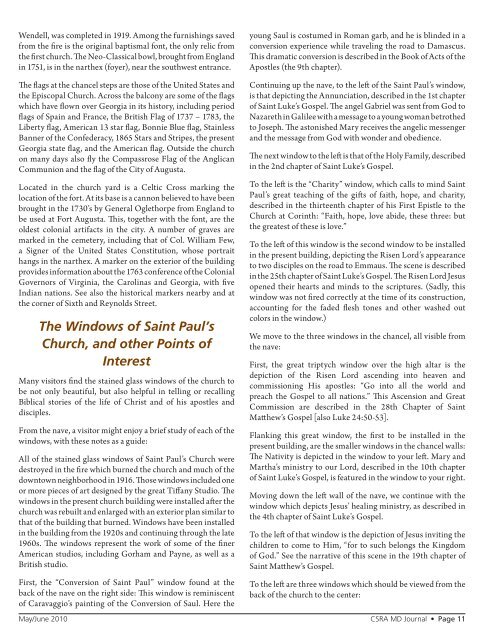Anna Kay Duckworth, MD - Savannah River Dermatology, LLC
Anna Kay Duckworth, MD - Savannah River Dermatology, LLC
Anna Kay Duckworth, MD - Savannah River Dermatology, LLC
- No tags were found...
Create successful ePaper yourself
Turn your PDF publications into a flip-book with our unique Google optimized e-Paper software.
Wendell, was completed in 1919. Among the furnishings savedfrom the fire is the original baptismal font, the only relic fromthe first church. The Neo-Classical bowl, brought from Englandin 1751, is in the narthex (foyer), near the southwest entrance.The flags at the chancel steps are those of the United States andthe Episcopal Church. Across the balcony are some of the flagswhich have flown over Georgia in its history, including periodflags of Spain and France, the British Flag of 1737 – 1783, theLiberty flag, American 13 star flag, Bonnie Blue flag, StainlessBanner of the Confederacy, 1865 Stars and Stripes, the presentGeorgia state flag, and the American flag. Outside the churchon many days also fly the Compassrose Flag of the AnglicanCommunion and the flag of the City of Augusta.Located in the church yard is a Celtic Cross marking thelocation of the fort. At its base is a cannon believed to have beenbrought in the 1730’s by General Oglethorpe from England tobe used at Fort Augusta. This, together with the font, are theoldest colonial artifacts in the city. A number of graves aremarked in the cemetery, including that of Col. William Few,a Signer of the United States Constitution, whose portraithangs in the narthex. A marker on the exterior of the buildingprovides information about the 1763 conference of the ColonialGovernors of Virginia, the Carolinas and Georgia, with fiveIndian nations. See also the historical markers nearby and atthe corner of Sixth and Reynolds Street.The Windows of Saint Paul’sChurch, and other Points ofInterestMany visitors find the stained glass windows of the church tobe not only beautiful, but also helpful in telling or recallingBiblical stories of the life of Christ and of his apostles anddisciples.From the nave, a visitor might enjoy a brief study of each of thewindows, with these notes as a guide:All of the stained glass windows of Saint Paul’s Church weredestroyed in the fire which burned the church and much of thedowntown neighborhood in 1916. Those windows included oneor more pieces of art designed by the great Tiffany Studio. Thewindows in the present church building were installed after thechurch was rebuilt and enlarged with an exterior plan similar tothat of the building that burned. Windows have been installedin the building from the 1920s and continuing through the late1960s. The windows represent the work of some of the finerAmerican studios, including Gorham and Payne, as well as aBritish studio.First, the “Conversion of Saint Paul” window found at theback of the nave on the right side: This window is reminiscentof Caravaggio’s painting of the Conversion of Saul. Here theyoung Saul is costumed in Roman garb, and he is blinded in aconversion experience while traveling the road to Damascus.This dramatic conversion is described in the Book of Acts of theApostles (the 9th chapter).Continuing up the nave, to the left of the Saint Paul’s window,is that depicting the Annunciation, described in the 1st chapterof Saint Luke’s Gospel. The angel Gabriel was sent from God toNazareth in Galilee with a message to a young woman betrothedto Joseph. The astonished Mary receives the angelic messengerand the message from God with wonder and obedience.The next window to the left is that of the Holy Family, describedin the 2nd chapter of Saint Luke’s Gospel.To the left is the “Charity” window, which calls to mind SaintPaul’s great teaching of the gifts of faith, hope, and charity,described in the thirteenth chapter of his First Epistle to theChurch at Corinth: “Faith, hope, love abide, these three: butthe greatest of these is love.”To the left of this window is the second window to be installedin the present building, depicting the Risen Lord’s appearanceto two disciples on the road to Emmaus. The scene is describedin the 25th chapter of Saint Luke’s Gospel. The Risen Lord Jesusopened their hearts and minds to the scriptures. (Sadly, thiswindow was not fired correctly at the time of its construction,accounting for the faded flesh tones and other washed outcolors in the window.)We move to the three windows in the chancel, all visible fromthe nave:First, the great triptych window over the high altar is thedepiction of the Risen Lord ascending into heaven andcommissioning His apostles: “Go into all the world andpreach the Gospel to all nations.” This Ascension and GreatCommission are described in the 28th Chapter of SaintMatthew’s Gospel [also Luke 24:50-53].Flanking this great window, the first to be installed in thepresent building, are the smaller windows in the chancel walls:The Nativity is depicted in the window to your left. Mary andMartha’s ministry to our Lord, described in the 10th chapterof Saint Luke’s Gospel, is featured in the window to your right.Moving down the left wall of the nave, we continue with thewindow which depicts Jesus’ healing ministry, as described inthe 4th chapter of Saint Luke’s Gospel.To the left of that window is the depiction of Jesus inviting thechildren to come to Him, “for to such belongs the Kingdomof God.” See the narrative of this scene in the 19th chapter ofSaint Matthew’s Gospel.To the left are three windows which should be viewed from theback of the church to the center:May/June 2010 CSRA <strong>MD</strong> Journal • Page 11


